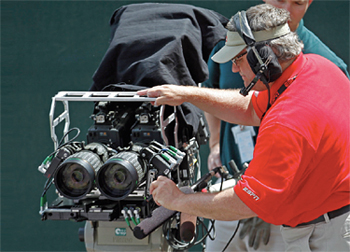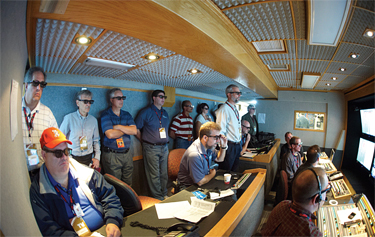Masters: ESPN Takes the 3D Plunge
AUGUSTA, GA
ESPN continues to gain 3DTV production expertise, as the network prepares for the launch of its ESPN 3D ad hoc TV service on June 11. From April 7-11, the venue was the 2010 Masters in Augusta, Ga. Using NEP Broadcasting’s Supershooter 3D production trailer—the 3D-capable truck that has been anchoring ESPN’s 3D coverage to date—the network provided viewers on Comcast, Cox, Time Warner, CableVision, Shaw and Bell in Canada, www.masters.com and selected closed-circuit TV locations with 10 hours of 720p 3D live programming over five days. The shoot was done using 10 pairs of Sony HD cameras; eight pairs of HDC-P1s and two pairs of HDC-1500s.

A technician works on a 3D camera before the 2010 Masters golf tournament at the Augusta National Golf Club in Augusta, Ga. last month. Gary Hershorn/Reuters/Landov “The broadcast was a bit limited in terms of what we could provide, given that we were only using 10 cameras,” said Phil Orlins, ESPN’s 3D Coordinating Producer. “Because of this, we opted to show people what the tournament could look like in 3D. So we didn’t try to spread ourselves thin to cover the en-tire course. Instead, we shot with multiple cameras at a few key locations and then put it together into cohesive 3D coverage with commentary, to provide examples of what is possible.”
THE PRODUCTION CHAIN
ESPN decided to cover most of the back 9 with its 10 cameras, three pairs of which were placed on jibs. (In order to shoot 3D video, two cameras are required for each position to provide “left eye” and “right eye” video.) The locations selected were the 11th green, which also had a clear shot of the 12th hole; a jib on the 14th green, a pair of cameras on the 16th hole; a jib on the 17th green and four cameras on the 18th hole. The last pair of cameras was used “to bounce around various locations depending on what was happening,” Orlins said. The cameras on the 11th green and 18th tee were robotically controlled; the rest were controlled by onsite camera people.
In general, the Sonys were equipped with 23:1 lenses, although the cameras on the 11th and 18th greens each had a pair of 42:1 lenses. “These are some of the longest lenses you can get for 3D cameras,” Orlins said.” They allowed us to get good views of the 16th tee as well as the green.”
Depending on the closeness of the 3D shot, ESPN used either side-by-side HD cameras or a pair of HD cameras connected to a single beam-splitter. Side-by-side cameras can only get so close to each other, which means they can’t provide the correct 3D depth of field on close shots. With a beam-splitter, a 45 degree see-through mirror within a special enclosed frame is used to provide images to two cameras, (the structure resembles a teleprompter). One camera is mounted horizontally, shooting through the mirror directly. The other camera is mounted vertically on top of the frame. It looks down into the box and captures the image reflected by the mirror.
“The beam-splitter allowed us to maintain the 3D depth of field even on the closest shots,” Orlins said. “For medium and far shots, the side-by-side rig provides controllable depth of field, because we can change it by physically widening or tightening the distance between the two cameras.”
The video from all 10 cameras was carried by fiber optic cable back to the NEP Supershooter 3D production trailer. Supershooter 3D uses a Fusion 3D production system capable of supporting up to eight pairs of HDTV cameras at a time (see “ESPN Preps for 3DTV,” April 12, 2010). Beyond the usual HD audio/video production equipment, this trailer offers “stereographer” positions named for the techs who visually balance the left and right fields to achieve the desired 3D look. Supershooter 3D also has three 6-channel EVS XT-2 servers, and four tape machines.
ESPN has been using Supershooter 3D for the last two years. To date, the network’s 3D shoots have included the fall 2009 USC vs. OSU college football game and a 2010 Harlem Globetrotters game at ESPN’s Innovation Lab in Orlando.
MASTERING 3D
Shooting the Masters in 3D for five days straight provided ESPN with a priceless commodity: experience. “3D is much more complicated to shoot and switch live than 2D is,” Orlins notes. “When we started the Masters shoot, we found ourselves struggling at first. But by the last day, working in this medium had started to become normal.”

ESPN used NEP Supershooter 3D truck to produce five days of 3D coverage of the Masters. Compared to 2D television, 3D directors tend to switch shots less often, and allow each shot to last longer. “The experience is akin to actually being there, if you do it right,” Orlins says. “So you don’t want to jump around too much.”
For 3DTV directors, managing their “depth of field budget” is an ongoing challenge. “I hate that term, but it sums up the problem: How much depth of field do you, as a director, choose for your viewers?” he says. “Do you take the ‘in your face’ approach, or do you use a more subtle depth of field approach that tastefully uses the available depth by immersing the viewer in the 3D experience?”
For the record, ESPN views the “in your face” version of 3D to be gratuitous and likely to irritate viewers over time. “We want to produce 3DTV that people can enjoy for hours at a time,” says Orlins. “Having a golf ball explode right in your face gets pretty wearing pretty soon.” The same restraint applies to graphics, he adds. “Again, viewers don’t like graphics that seem to sit in their laps.”
ESPN’s limited 3D coverage of the 2010 Masters was an educational experience for the network. “The main thing we learned is that we’re a lot closer to getting a handle on producing 3D coverage than we were before the Masters,” Orlins said. “The day-after-day production allowed us to get accustomed to working with 3DTV; to develop real expertise and familiarity.”
In gaining this level of expertise, ESPN’s 3D production team has advanced from being newbies to 3DTV journeymen. “As a result, we’re a lot closer to ramping up to the same aggressive pace that we did in mastering 2D HDTV,” says Orlins. “The timing couldn’t be better, given that ESPN 3D is about to launch!”
Get the TV Tech Newsletter
The professional video industry's #1 source for news, trends and product and tech information. Sign up below.
James Careless is an award-winning journalist who has written for TV Technology since the 1990s. He has covered HDTV from the days of the six competing HDTV formats that led to the 1993 Grand Alliance, and onwards through ATSC 3.0 and OTT. He also writes for Radio World, along with other publications in aerospace, defense, public safety, streaming media, plus the amusement park industry for something different.

